高一英语(必修一)
人教版高一英语必修一单词表(完整版)
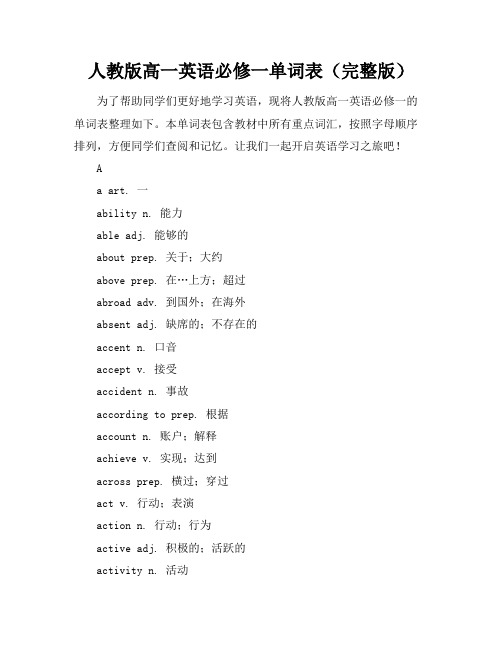
人教版高一英语必修一单词表(完整版)为了帮助同学们更好地学习英语,现将人教版高一英语必修一的单词表整理如下。
本单词表包含教材中所有重点词汇,按照字母顺序排列,方便同学们查阅和记忆。
让我们一起开启英语学习之旅吧!Aa art. 一ability n. 能力able adj. 能够的about prep. 关于;大约above prep. 在…上方;超过abroad adv. 到国外;在海外absent adj. 缺席的;不存在的accent n. 口音accept v. 接受accident n. 事故according to prep. 根据account n. 账户;解释achieve v. 实现;达到across prep. 横过;穿过act v. 行动;表演action n. 行动;行为active adj. 积极的;活跃的activity n. 活动actor n. 演员actress n. 女演员actual adj. 实际的ad n. 广告add v. 添加;加addition n. 添加;加法additional adj. 额外的;附加的address n. 地址adequate adj. 足够的;适当的adjust v. 调整;适应adjustment n. 调整;调节advantage n. 优势;利益adventure n. 冒险;冒险活动adverb n. 副词advertisement n. 广告advice n. 建议;忠告advise v. 建议;劝告affair n. 事务;事件affect v. 影响afraid adj. 害怕的;担心的after prep. 在…之后;后来afternoon n. 下午afterward adv. 后来;随后again adv. 再次;又against prep. 反对;靠着age n. 年龄;时代ago adv. 以前agree v. 同意agreement n. 协议;同意ahead adv. 在前面;向前aid n. 援助;帮助aim n. 目标;目的air n. 空气;气氛airline n. 航班;航空公司airport n. 机场alive adj. 活着的;活泼的all adj./pron. 所有;全部allow v. 允许;许可almost adv. 几乎;差不多alone adj. 单独的;孤独的along prep. 沿着;顺着already adv. 已经also adv. 也;同样although conj. 尽管;虽然altitude n. 高度;海拔always adv. 总是;一直am v. be的第一人称单数现在时amazing adj. 令人惊讶的ambulance n. 救护车America n. 美国American adj. 美国的;美国人的among prep. 在…之中amount n. 金额;数量ampere n. 安培amusement n. 娱乐;消遣anchor n. 锚;主播ancient adj. 古代的;古老的and conj. 和;与angle n. 角度;观点angry adj. 生气的;愤怒的animal n. 动物announce v. 宣布;宣告announcement n. 宣告;通告announcer n. 广播员;宣告者another pron./adj. 另一个;又一answer v./n. 回答;答复ant n. 蚂蚁any pron./adj. 任何;一些anybody pron. 任何人anyone pron. 任何人anything pron. 任何事物anyway adv. 无论如何;anywhere adv. 任何地方apart adv. 相隔;分开apartment n. 公寓apologize v. 道歉apology n. 道歉;歉意apparatus n. 设备;仪器apparent adj. 明显的;显然的appeal n./v. 吸引力;呼吁appear v. 出现;显得appearance n. 出现;外观apple n. 苹果application n. 申请;应用apply v. 申请;应用appoint v. 任命;指定appointment n. 约会;任命appreciate v. 欣赏;感激approach v./n. 接近;方法appropriate adj. 适当的;合适的approve v. 批准;同意approximate adj. 大概的;大约的approximately adv. 大约;近似地April n. 四月arbitrary adj.arch n. 拱门;拱形结构area n. 区域;面积argue v. 争论;辩论argument n. 争论;论点arise v. 出现;发生arm n. 手臂;武器armchair n. 扶手椅army n. 军队around prep. 围绕;大约arrange v. 安排;整理arrangement n. 安排;整理arrival n. 到达;到达者arrive v. 到达;抵达arrow n. 箭;箭头art n. 艺术;艺术品article n. 文章;物品artificial adj. 人造的;假的artist n. 艺术家as conj. 作为;当作ash n. 灰烬;骨灰ashamed adj. 感到羞耻的aside adv. 在旁边;另外ask v. 询问;请求asleep adj. 睡着的aspect n. 方面;面貌assemble v. 集合;组装assembly n. 集会;组装assess v. 评估;评定assign v. 分配;指派assignment n. 任务;作业assist v. 帮助;协助assistant n. ;助理associate v. 联系;交往association n. 协会;联系assume v. 假设;承担assure v. 保证;确保astonish v. 使惊讶astronaut n. 宇航员at prep. 在;于athlete n. 运动员atmosphere n. 大气;气氛attach v. 附上;贴上attack v./n. 攻击;进攻attempt v./n. 尝试;努力attend v. 出席;参加attention n. 注意;关注attentive adj. 注意的;专心的attitude n. 态度;看法attract v. 吸引attraction n. 吸引力;吸引物attribute v. 归因于;认为…是audience n. 观众;听众August n. 八月aunt n. 伯母;阿姨author n. 作者authority n. 权力;权威auto n. 汽车automatic adj. 自动的automobile n. 汽车autumn n. 秋天;秋季auxiliary adj. 辅助的;备用的avail v. 利用;有益于available adj. 可用的;可得到的avenue n. 大道;林荫路average adj. 平均的;普通的avoid v. 避免;避开await v. 等待;期待awake adj. 醒着的award n./v. 奖品;授予aware adj. 知道的;意识到的away adv. 离开;远离awful adj. 糟糕的;可怕的awkward adj. 尴尬的;笨拙的Bba n. 婴儿bachelor n. 学士;单身汉back adv./n. 后面;背部background n. 背景;经历backward adv. 向后;倒退bacon n. 培根;熏肉bacterium n. 细菌bad adj. 坏的;差的badminton n. 羽毛球bag n. 袋子;包baggage n. 行李bake v. 烤;烘焙balance n. 平衡;余额balcony n. 阳台ball n. 球;舞会balloon n. 气球banana n. 香蕉band n. 乐队;带子bandage n. 绷带bang n./v. 砰的一声;猛击bank n. 银行;河岸bar n. 栅栏;酒吧barbecue n. 烧烤;烤肉barber n. 理发师bare adj. 赤裸的;光秃的bargain n. 交易;便宜货bark n./v. 吠叫;树皮base n. 基础;基地baseball n. 棒球basic adj. 基本的;基础的basically adv. 基本上;大致上basin n. 盆地;水盆basket n. 篮子basketball n. 篮球bat n. 蝙蝠;球拍bbatch n. 一批;一组bath n. 洗澡;浴室bathe v. 洗澡;游泳bathroom n. 浴室battery n. 电池battle n. 战斗;斗争bay n. 湾;海湾be v. 是(be动词的所有形式)beach n. 海滩beam n. 梁;光线bean n. 豆;豆类bear n. 熊beard n. 胡须beat v. 打;打败beautiful adj. 美丽的beauty n. 美丽;美人because conj. 因为bed n. 床bedroom n. 卧室bee n. 蜜蜂beef n. 牛肉beehive n. 蜂箱beer n. 啤酒before prep./conj. 在…之前beg v. 请求;乞求begin v. 开始beginning n. 开始;起点behalf n. 代表;利益behave v. 行为;表现behavior n. 行为;举止behind prep. 在…后面being n. 存在;生物belief n. 信念;信仰believe v. 相信;认为bell n. 钟;铃belong v. 属于beloved adj. 心爱的;亲爱的below prep. 在…下面belt n. 腰带;带子bench n. 长凳;工作台bend v. 弯曲;屈服beneath prep. 在…下方benefit n. 利益;好处beside prep. 在…旁边besides prep. 除…之外bet v. 打赌;赌注between prep. 在…之间beyond prep. 超出;在…之外Bible n. 圣经bicycle n. 自行车bid v. 出价;邀请big adj. 大的bike n. 自行车bill n. 账单;钞票billion num. 十亿bin n. 垃圾箱;箱子bind v. 捆绑;约束biology n. 生物学bird n. 鸟birth n. 出生;诞生birthday n. 生日bit n. 一点儿;位bite v./n. 咬;叮bitter adj. 苦的;痛苦的bitterly adv. 苦涩地;痛苦地black adj. 黑色的blackboard n. 黑板blade n. 刀片;叶片blame v. 责备;归咎于blank adj. 空白的;茫然的blanket n. 毛毯;覆盖物blast n. 爆炸;冲击波bleed v. 流血;渗出blend v. 混合;融合bless v. 祝福;保佑blind adj. 盲的;失明的block n. 块;街区blood n. 血液;血统bloom n. 花;开花blossom n. 花;开花blow v. 吹;吹动blue adj. 蓝色的board n. 板;委员会boat n. 船;小舟body n. 身体;主体boil v. 沸腾;煮bold adj. 大胆的;粗体的bolt n. 螺栓;闪电bomb n. 炸弹bond n. 债券;联系bone n. 骨头bonus n. 奖金;额外福利book n. 书;预订boom v. 繁荣;迅速增长boot n. 靴子booth n. 货摊;电话亭border n. 边界;边缘bore v. 使厌烦;钻孔born adj. 出生的borrow v. 借;借用boss n. 老板;上司both pron./adj. 两个都bother v. 打扰;麻烦bottle n. 瓶子bottom n. 底部;底端bounce v. 弹跳;反弹bound v. 跳跃;束缚boundary n. 边界;界限bow n. 弓;鞠躬bowl n. 碗;碗状物box n. 盒子;拳击boy n. 男孩brace v. 支撑;加固。
高一英语必修一知识点总结范文(通用10篇)
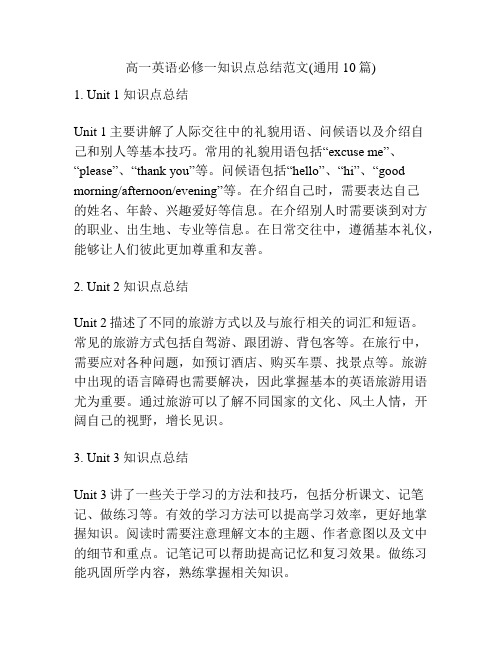
高一英语必修一知识点总结范文(通用10篇)1. Unit 1 知识点总结Unit 1主要讲解了人际交往中的礼貌用语、问候语以及介绍自己和别人等基本技巧。
常用的礼貌用语包括“excuse me”、“please”、“thank you”等。
问候语包括“hello”、“hi”、“good morning/afternoon/evening”等。
在介绍自己时,需要表达自己的姓名、年龄、兴趣爱好等信息。
在介绍别人时需要谈到对方的职业、出生地、专业等信息。
在日常交往中,遵循基本礼仪,能够让人们彼此更加尊重和友善。
2. Unit 2 知识点总结Unit 2描述了不同的旅游方式以及与旅行相关的词汇和短语。
常见的旅游方式包括自驾游、跟团游、背包客等。
在旅行中,需要应对各种问题,如预订酒店、购买车票、找景点等。
旅游中出现的语言障碍也需要解决,因此掌握基本的英语旅游用语尤为重要。
通过旅游可以了解不同国家的文化、风土人情,开阔自己的视野,增长见识。
3. Unit 3 知识点总结Unit 3讲了一些关于学习的方法和技巧,包括分析课文、记笔记、做练习等。
有效的学习方法可以提高学习效率,更好地掌握知识。
阅读时需要注意理解文本的主题、作者意图以及文中的细节和重点。
记笔记可以帮助提高记忆和复习效果。
做练习能巩固所学内容,熟练掌握相关知识。
4. Unit 4 知识点总结Unit 4阐述了一些与课业和学校相关的主题,包括课程设置、学生管理、选修课程等。
学校的课程设置和学生管理对个人学习效果和成长影响极大。
因此,学生需要选择喜欢的课程、寻求辅导或者参加校内课外活动等方式进行学习和提高自己的能力。
5. Unit 5 知识点总结Unit 5集中介绍了环保有关的知识和立场。
保护环境是人类共同的责任,应该采取积极的行动保护地球。
环保的方式多种多样,如减少使用一次性物品、垃圾分类、使用运动出行等。
同时,政府和企业也应该为环保出一份力,加强环保立法,鼓励开发新能源和技术,降低碳排放等。
高一英语(必修一)

treatment painful damage attractive embarrassed pressure overweight diet go on a diet prefer waist suffer athlete effect side effect fall out affect achievement post membership including branch downtown freeway midnight equipment get into shape make the most of marathon expert chip sadness comfort useless in the long term approximately skip properly mostly system skin count peaceful concentrate amount as a matter of fact loss gain
broadcast preparation event outing graduation poet generation literary select courtard composition act curtain can't wait to do something soccer frightened be supposed to bend starve cash garbage pizza sink garbage can adult tolerate behavior teenager fault scene upset defend emergency anyhow deserve explanation clinic hard be hard on now that rude sigh bicycle hardworking stay up handle error
英语高一必修一语法

英语高一必修一语法英语高一必修一的语法部分主要涵盖了基本句型、时态、动词的用法等内容。
本文将详细介绍其中的几个重要的语法知识点。
一、基本句型英语中的基本句型有五种,分别是陈述句、疑问句、祈使句、感叹句和条件句。
1. 陈述句:陈述句是表达事实或陈述观点的句子。
它的基本结构是主语+谓语+宾语,谓语可以是及物动词或不及物动词。
例如:- I like apples.- They are playing basketball.2. 疑问句:疑问句是用来提问的句子。
它的基本结构是助动词/系动词+主语+谓语+其他成分?例如:- Do you like apples?- Are they playing basketball?3. 祈使句:祈使句是用来表达请求、命令、建议等意思的句子。
它的基本结构是谓语+其他成分。
例如:- Close the door, please.- Don't play with fire.4. 感叹句:感叹句是表达强烈感情或赞叹的句子。
它的基本结构是How/What+形容词/副词+主语+谓语。
例如:- How beautiful the flowers are!- What a lovely day it is!5. 条件句:条件句是表示条件的句子。
它的基本结构是if/whether+句子。
例如:- If it rains tomorrow, we will stay at home.- Whether she comes or not, I will go to the party.二、时态在英语中,时态用于表示动作发生的时间。
高一必修一中涵盖了一般现在时、一般过去时、一般将来时等几个基本时态。
1. 一般现在时:一般现在时用于表示经常性的动作、习惯、真理、科学事实等。
它的基本结构是主语+谓语。
例如:- She goes to school every day.- Water boils at 100 degrees Celsius.2. 一般过去时:一般过去时用于表示过去发生的动作或状态。
高一年级英语必修一知识点笔记

高一年级英语必修一知识点笔记(实用版)编制人:______审核人:______审批人:______编制单位:______编制时间:__年__月__日序言下载提示:该文档是本店铺精心编制而成的,希望大家下载后,能够帮助大家解决实际问题。
文档下载后可定制修改,请根据实际需要进行调整和使用,谢谢!并且,本店铺为大家提供各种类型的实用资料,如教案大全、书信范文、述职报告、合同范本、工作总结、演讲稿、心得体会、作文大全、工作计划、其他资料等等,想了解不同资料格式和写法,敬请关注!Download tips: This document is carefully compiled by this editor.I hope that after you download it, it can help you solve practical problems. The document can be customized and modified after downloading, please adjust and use it according to actual needs, thank you!Moreover, our store provides various types of practical materials for everyone, such as lesson plans, letter templates, job reports, contract templates, work summaries, speeches, reflections, essay summaries, work plans, and other materials. If you want to learn about different data formats and writing methods, please stay tuned!高一年级英语必修一知识点笔记本店铺为各位同学整理了《高一年级英语必修一知识点笔记》,希望对你的学习有所帮助!1.高一年级英语必修一知识点笔记篇一主动形式表被动意义①当feel、look、smell、taste、sound等后面接形容词时;当cut、read、sell、wear、write等词带状语修饰语时;当动词表示开始、结束、关、停、转、启动等意义时。
高一英语必修一英语单词表
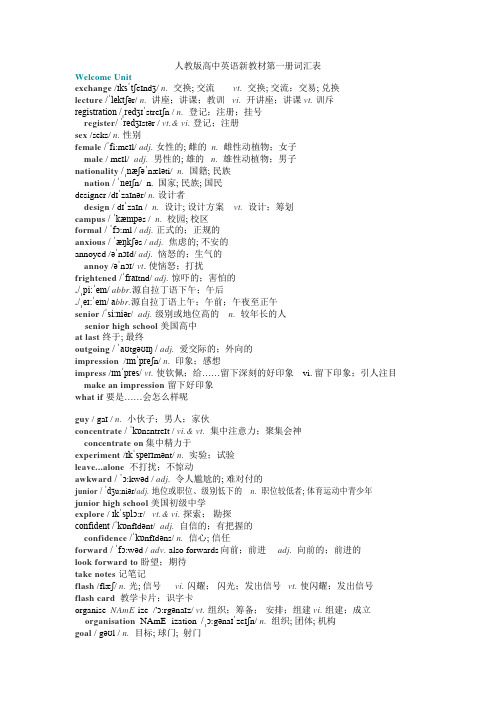
人教版高中英语新教材第一册词汇表Welcome Unitexchange /ɪksˈtʃeɪndʒ/ n. 交换; 交流vt. 交换; 交流;交易; 兑换lecture/ˈlektʃər/ n.讲座;讲课;教训 vi. 开讲座;讲课vt. 训斥registration /ˌredʒɪˈstreɪʃn / n. 登记;注册;挂号register/ ˈredʒɪstər / vt.& vi. 登记;注册sex /seks/ n. 性别female/ˈf i:meɪl/ adj.女性的; 雌的 n. 雌性动植物;女子male / meɪl/ adj. 男性的; 雄的n. 雄性动植物;男子nationality/ˌnæʃəˈnæləti/ n. 国籍; 民族nation/ ˈneɪʃn/ n. 国家; 民族; 国民designer /dɪˈzaɪnər/ n.设计者design / dɪˈzaɪn / n. 设计; 设计方案 vt. 设计;筹划campus/ ˈkæmpəs / n.校园; 校区formal / ˈfɔ:ml / adj.正式的;正规的anxious/ ˈæŋkʃəs / adj.焦虑的; 不安的annoyed /əˈnɔɪd/ adj.恼怒的;生气的annoy /əˈnɔɪ/ vt. 使恼怒;打扰frightened/ˈfraɪtnd/ adj. 惊吓的;害怕的./ˌpi:ˈem/abbr.源自拉丁语下午;午后./ˌeɪ:ˈem/ a bbr.源自拉丁语上午;午前;午夜至正午senior/ˈsi:niər/ adj.级别或地位高的 n. 较年长的人senior high school美国高中at last 终于; 最终outgoing/ ˈaʊtgəʊɪŋ /adj.爱交际的;外向的impression /ɪmˈpreʃn/ n.印象;感想impress /ɪmˈpres/ vt.使钦佩;给……留下深刻的好印象 vi. 留下印象;引人注目make an impression 留下好印象what if 要是……会怎么样呢guy / gaɪ / n. 小伙子;男人;家伙concentrate/ ˈkɒnsntreɪt / vi.& vt.集中注意力;聚集会神concentrate on集中精力于experiment /ɪkˈsperɪmənt/ n.实验;试验leave...alone不打扰;不惊动awkward/ ˈɔ:kwəd / adj.令人尴尬的; 难对付的junior/ ˈdʒu:niər/adj.地位或职位、级别低下的n.职位较低者; 体育运动中青少年junior high school美国初级中学explore / ɪkˈsplɔ:r/ vt.& vi. 探索;勘探confident /ˈkɒnfɪdənt/ adj.自信的;有把握的confidence/ˈkɒnfɪdəns/ n. 信心; 信任forward/ ˈfɔ:wəd / adv. also forwards向前;前进adj.向前的;前进的look forward to 盼望;期待take notes 记笔记flash /flæʃ/ n. 光; 信号 vi. 闪耀;闪光;发出信号vt. 使闪耀;发出信号flash card教学卡片;识字卡organise NAmE-ize /'ɔ:rgənaɪz/ vt. 组织;筹备;安排;组建vi.组建;成立organisation NAmE- ization /ˌɔ:gənaɪˈzeɪʃn/ n.组织; 团体; 机构goal / gəʊl / n. 目标; 球门; 射门strategy/ˈstrætədʒi/ n. 策略;策划partner/ ˈpɑ:tnər/n.同伴; 配偶;合伙人improve / ɪmˈpru:v/ vi.&vt.改进;改善curious/ˈkjʊəriəs/ adj.好奇的; 求知欲强的company/ ˈkʌmpəni/ n. 公司;商行; 陪伴personality/ ˌpɜ:səˈnæləti / n.性格;个性style / staɪl/ n.方式; 作风revise / rɪˈvaɪz/ vt.& vi. 修改; 修订;复习Unit 1teenage / ˈti:neɪdʒ/ adj.十几岁的指13至19岁; 青少年的teenager/ ˈti:neɪdʒər/ n. 13至19岁之间的青少年ballet/ˈbæleɪ/ n. 芭蕾舞;芭蕾舞剧volunteer/ˌvɒlənˈtɪər/ n. 志愿者debate /dɪ 'beɪt/ n.辩论;争论 vt.& vi.辩论;争论prefer / prɪˈfɜ:r/ vt.较喜欢 preferred; preferred; preferringprefer…to …喜欢……多于……content / 'kɒntent / n.内容; pl 目录; 书、讲话、节目等的主题movement/ ˈmu:vmənt / n.动作;运动; 活动greenhouse/ ˈgri:nhaʊs/ n.温室;暖房clean up打扫或清除干净suitable/ˈsu:təbl/ adj. 适合的;适用的suitable for对……适合的actually / ˈæktʃuəli/ adv.事实上; 的确challenge /ˈtʃæləndʒ/ n.挑战;艰巨任务 vt.怀疑;向……挑战title /ˈtaɪtl/ n. 书、诗歌等的名称;标题;职称;头衔topic /ˈtɒpɪk/ n. 话题; 标题freshman / ˈfreʃmən / n.especially NAmE中学九年级学生;大学一年级新生confusing /kənˈfju:zɪŋ/adj.难以理解的;不清楚的confuse /kən'fju:z/ vt.使糊涂;使迷惑confused /kənˈfju:zd/ adj.糊涂的;迷惑的fluent /'flu:ənt/ adj.尤指外语流利的;熟练的graduate /'ɡrædʒʊeɪt/ vi. & vt.毕业;获得学位 /'ɡrædʒʊət/ n.毕业生recommend /ˌrekəˈmend/ vt.建议;推荐;介绍sign up for sth报名参加课程advanced / ədˈvɑ:nst/adj. 高级的;高等的;先进的advance / ədˈvɑ:ns /n.前进;发展 vi.前进;发展 vt.发展;促进literature / ˈlɪtrətʃər/ n.文学; 文学作品extra-curricular / 'ekstrəkə'rɪkjulə/ adj. 课外的; 课程以外的extra /'ekstrə/ adj.额外的;附加的obviously / ˈɒbviəsli/ adv.显然地;明显地quit / kwɪt/ vi. & vt.quit, quit 停止;戒掉;离开工作职位、学校等responsible /rɪˈspɒnsəbl/ adj.负责的;有责任的responsibilit y /rɪˌspɒnsəˈbɪləti/ n.责任;义务be responsible for 对……负责solution / səˈlu:ʃn/ n.解决办法; 答案schedule /ˈʃedju:l; NAmEˈskedʒul /n.工作计划;日程安排 vt.安排;预定editor /ˈedɪtər/ n.主编;编辑;编者plate /pleɪt/ n.盘子,碟子adventur e /ədˈventʃər/ n.冒险; 奇遇youth/ju:θ/n.青年时期; 青春survival/səˈvaɪvl/ n.生存;幸存;幸存事物expert /'ekspɜːt/ n.专家;行家adj.熟练的;内行的;专家的behaviour /bɪˈheɪvjər/ n.行为; 举止generation /ˌdʒenəˈreɪʃn/ n.一代人attract /ə'trækt/ vt.吸引;引起……的注意或兴趣be attracted to 喜爱focus / ˈfəʊkəs / vi.& vt. 集中精力、注意力等;使调节焦距n.中心;重点;焦点focus on集中;特别关注addicted /əˈdɪktɪd/ adj.有瘾的;上瘾的;入迷的addict /ˈædɪkt/ n.对……入迷的人;吸毒成瘾的人addicted to对……很入迷adult /ˈædʌlt/ n.成年人adj.成年的;成熟的Unit 2castle /ˈkɑ:sl/ n.城堡;堡垒apply /əˈplaɪ/ vi. & vt.申请;请求 vt. 应用; 涂油漆、乳剂apply for申请visa /ˈvi:zə/ n. 签证rent / rent/ vt.租用;出租 vi.租用;租金为 n.租金pack /pæk/ vi. & vt.收拾行李 vt.包装n.商品的纸包;纸袋;大包amazing /əˈmeɪzɪŋ/adj.令人惊奇的;令人惊喜的amazed /əˈmeɪzd/ adj.惊奇的;惊喜的arrangement /əˈreɪndʒmənt/ n.安排;筹备extremely /ɪkˈstri:mli / adv.极其; 非常source /sɔ:s/ n. 来源;出处narrow /ˈnærəʊ/ adj. 狭窄的 vi.& vt.使变窄flat /flæt /adj. 平坦的; 扁平的 n.公寓; 单元房powerful /ˈpaʊəfl / adj.强有力的;有权势的;有影响力的empire /ˈempaɪər/ n.帝国emperor / ˈempərər/ n. 皇帝site /saɪt / n. 地点;位置;现场take control of 控制; 接管official /ə'fɪʃl/ adj.官方的;正式的; 公务的 n. 官员;要员recognise NAmE -ize /ˈrekəgnaɪz/ vt.辨别出; 承认; 认可type /taɪp/ n.类型; 种类 vi. & vt. 打字flight /flaɪt/ n. 空中航行; 航班;航程accommodation /əˈkɒməˌdeɪʃn/ n. 住处;停留处;膳宿unique /juˈni:k/ adj.唯一的;独特的; 特有的path /pɑ:θ/n.小路; 路线;道路destination /ˌdestɪˈneɪʃn/ n.目的地;终点other than除……以外admire /ədˈmaɪər/ vt.钦佩;赞赏architecture /ˈɑ:kɪtektʃər / n.建筑设计;建筑学architect /ˈɑ:kɪtekt / n.建筑设计师brochure /ˈbrəʊʃər; NAmE broʊˈʃʊr/ n.资料或广告手册package /ˈpækɪdʒ/ n.包裹; 包装盒 vt.将……包装好package tour包价旅游contact /ˈkɒntækt / vt. 联络;联系 n.联系;接触civilisation NAmE -ization /ˌsɪvəlaɪˈzeɪʃn/ n.文明;闻名世界make up构成;形成soldier /ˈsəʊldʒər/ n.士兵; 军人transport / ˈtrænspɔ:t/ n.especially BrENAmE usually transportation交通运输系统 vt.运输;运送hike / haɪk /vi.徒步旅行 vt.去……远足 n.远足; 徒步旅行economy /ɪˈkɒnəmi/ n.经济; 节约economic /ˌi:kəˈnɒmɪk/ adj.经济上的; 经济学的credit /ˈkredɪt/ n. 借款;信用; 称赞; 学分credit card信用卡detail /ˈdi:teɪl / n.细节;详情;细微之处check in在旅馆、机场等登记check out结账离开旅馆等request /rɪˈkwest/ n. 正式或礼貌的要求;请求 vt.正式或礼貌地要求;请求view / vju:/ n.视野;景色;看法sight /saɪt/ n.景象; 视野; 视力statue /ˈstætʃu:/ n.雕塑;雕像BCE /ˌbi: si: ˈi:/ =before the Common Era 公元前tomb / tu:m / n. 坟墓unearth / ʌnˈɜ:θ/ vt.挖掘;发掘comment /ˈkɒment/ n.议论;评论 vi.& vt.发表意见;评论Unit 3fitness /ˈfɪtnəs/ n.健康; 健壮;适合soccer /ˈsɒkər/ n.足球;足球运动stadium /ˈsteɪdiəm/ n.pl. stadiums or stadia体育场; 运动场boxing /ˈbɒksɪŋ / n.拳击运动badminton /ˈbædmɪntən/ n.羽毛球运动event / ɪˈvent/ n.比赛项目;大事;公开活动come along跟随;到达;进步;赶快ski / ski:/ adj.滑雪的 vi.滑雪host /həʊst/ vt.主办;主持 n.主人;东道主;节目主持人track /træk/ n.跑道;足迹;铁路轨道 vt.& vi.追踪; 跟踪track and field田径gym / dʒɪm / n.健身房; 体育馆gymnastics /dʒɪmˈnæstɪks/ n.体操训练work out锻炼;计算出;解决sweat /swet / vt.使出汗;出汗弄湿 vi.出汗;流汗 n.汗水; 出汗make it获得成功;准时到达legend /ˈledʒənd / n.传奇故事或人物;传说athlete /ˈæθli:t/ n.运动员;运动健儿master /ˈmɑ:stər/ n. 高手; 主人vt. 精通;掌握set an example树立榜样honour /ˈɒnər/ n.荣誉;尊敬;荣幸glory /ˈglɔ:ri / n.荣誉;光荣;赞美medal /ˈmedl/ n.奖章; 勋章championship /ˈtʃæmpiənʃɪp / n. 锦标赛; 冠军赛;冠军称号champion /ˈtʃæmpiən/ n.冠军; 优胜者determination /dɪˌtɜ:mɪˈneɪʃn/ n.决心;决定apart /əˈpa:t/ adv.分离;分开;成碎片fall apart破裂;破碎;崩溃injure /ˈɪndʒər/ vt.使受伤;损害injured /ˈɪndʒəd / adj. 受伤的;有伤的injury /ˈɪndʒəri / n.伤害;损伤captain /ˈkæptɪn / n.运动队队长;船长;机长lose heart丧失信心;泄气graceful /ˈgreɪsfl / adj.优美的;优雅的strength/streŋθ/n.力量;体力failure /ˈfeɪljər / n.失败;失败的人或事物give up放弃;投降compete / kəmˈpi:t / vi.竞争;对抗make sense有道理;合乎情理;表述清楚pretend /prɪˈtend/ vi.& vt.假装;装扮pretend to do sth 假装做某事even if/though即使;虽然million /ˈmɪljən / num.一百万cheat / tʃi:t / vi.作弊;舞弊vt.欺骗;蒙骗 n. 欺骗手段;骗子audience /ˈɔːdiəns / n.观众;听众positive /ˈpɒzətɪv / adj.积极的;正面的;乐观的;肯定的slim /slɪm / adj. 苗条的;单薄的diet /ˈdaɪət / n.规定饮食;日常饮食 vi.节食make a differenc e有作用或影响rather /ˈrɑ:ðər / adv.相当;有点儿rather than而不是push-up /ˈpʊʃʌp / n. especially NAmE俯卧撑cut ...out 停止做或使用、食用;剪下now and the n有时;偶尔compare … with/to…与……比较jog / dʒɒg / vi.慢跑 n.慢跑stress /stres/ n.压力;紧张;重音 vt.强调;重读;使焦虑不安 vi.焦虑不安error / ˈerər / n.错误;差错Unit 4disaster / dɪˈzɑ:stər / n.灾难;灾害tornado /tɔ:ˈneɪdəʊ / n.pl. -oes or -os 龙卷风;旋风drought / draʊt / n.旱灾;久旱landslide / ˈlændslaɪd / n. landfall 山地或悬崖的崩塌;滑坡slide / slaɪd / vi. & vt.使滑行;滑动tsunami / tsu:ˈnɑ:mi /n.海啸flood /flʌd / n.洪水;大量 vi.淹没;大量涌入 vt.使灌满水;淹没volcanic eruption / vɔlˈkænɪk ɪˈrʌpʃn / 火山喷发magnitude /ˈmægnɪtju:d / n.地震级;重大rescue /ˈreskju:/ n.& vt.营救;救援damage /ˈdæmɪdʒ / vt.损害;破坏 n.损坏;损失destroy /dɪ'strɔɪ/ vt.摧毁;毁灭evacuate /ɪˈvækjueɪt / vt.疏散;撤出 vi.撤离helicopter /ˈhelɪkɒptər/ n.直升机death/ deθ/n. 死;死亡affect /ə'fekt/ vt.影响;疾病侵袭;深深打动shelter /'ʃeltər/ n.避难处;居所;庇护 vt.保护;掩蔽 vi.躲避风、雨或危险crack /kræk/ n.裂纹;裂缝vi. & vt. 使破裂as if似乎;好像;仿佛ruin /'ru:ɪn/ n.&vt. 破坏;毁坏in ruins 严重受损;破败不堪percent / pəˈsent / n.百分之……adj.&adv.每一百种brick /brɪk/ n.砖;砖块metal /'metl/ n.金属shock /ʃɒk/ n.震惊;令人震惊的事;休克vt.使震惊in shock 震惊;吃惊electricity /ɪˌlekˈtrɪsəti/ n.电;电能trap /træp/ vt.使落入险境;使陷入圈套 n.险境;陷阱bury /ˈberi/ vt.埋葬;安葬breathe / bri:ð/ vi.& vt.呼吸revive /rɪˈvaɪv/ vt.& vi.复活;使苏醒revival /rɪˈvaɪvl/ n.振兴;复苏effort /'efət/ n.努力;艰难的尝试;尽力unify /ˈju:nɪfaɪ / vi.& vt.统一;使成一体wisdom /ˈwɪzdəm/ n.智慧;才智context /ˈkɒntekst/ n.上下文;语境;背景suffer /ˈsʌfə/ vt.遭受;蒙受vi.因疾病、痛苦、悲伤等受苦volcano /vɒlˈkeɪnəʊ/ n.pl. -oes or -os火山erupt /ɪˈrʌpt/ vi.& vt.火山爆发;岩浆、烟等喷出supply /səˈplaɪ/ n.供应量;补给;pl. 补给品vt.供应;供给typhoon /taɪˈfu:n/ n.台风in the open air露天;在户外hurricane /ˈhʌrɪkən/ n .尤指大西洋的飓风survive /səˈvaɪv/ vi.生存;存活 vt. 幸存;艰难度过power /ˈpaʊər/ n.电力供应;力量;控制力tap /tæp/ vi.& vt.轻叩;轻敲;轻拍n.水龙头;轻叩;轻敲pipe /paɪp/ n.管子;管道whistle /ˈwɪsl/ vi.吹口哨;发出笛声 vt.吹口哨 n.哨子声;呼啸声emergency /iˈmɜ:dʒənsi/ n.突发事件;紧急情况calm /kɑ:m/adj.镇静的;沉着的 vt.使平静;使镇静aid /eɪd/ n.援助;帮助;救援物资 vi.& vt.formal帮助;援助kit /kɪt/ n.成套工具;成套设备first aid kit急救箱on hand现有尤指帮助crash /kræʃ/ vt.& vi.碰撞;撞击 n.撞车;碰撞sweep /swi:p/ vt. & vi. swept, swept 打扫;清扫sweep away消灭;彻底消除wave /weɪv/ n.海浪;波浪vi.& vt.挥手;招手strike /straɪk/ vi.& vt. struck, struck/stricken 侵袭;突击;击打 n. 罢工;罢课;袭击deliver /dɪˈlɪvər/ vt. & vi.递送;传达vt.发表summary /ˈsʌməri/ n.总结;概括;概要effect /ɪˈfekt/ n.影响;结果;效果length/leŋθ/n.长;长度Unit 5billion /ˈbɪljən / n.十亿native /ˈneɪtɪv/ adj.出生地的;本地的;土著的 n.本地人attitude /ˈætɪtju:d; NAmE 'ætitu:d/ n.态度;看法reference /ˈrefrəns / n.指称关系;参考refer / rɪˈfɜ:r / referred , referred , referring vi.提到;参考;查阅vt.查询;叫…求助于 refer to指的是;描述;提到;查阅system /ˈsɪstəm / n.体系;制度;系统despite /dɪˈspaɪt / prep.即使;尽管ups and downs浮沉;兴衰;荣辱factor /ˈfæktər/ n. 因素;要素based /beɪst/ adj.以某事为基础的;以……为重要部分或特征的base /beɪs/ vt.以……为据点;以……为基础n. 底部;根据date back to ...追溯到bone / bəʊn / n.骨头;骨质shell /ʃel / n.壳;壳状物symbol /ˈsɪmbl / n. 符号;象征carve / kɑ:v /vt. & vi 雕刻dynasty /ˈdɪnəsti; NAmE ' dai-/ n.王朝;朝代variety /vəˈraɪəti/ n.植物、语言等的变体;异体;多样化major /ˈmeɪdʒər/ adj.主要的;重要的;大的 n.主修课程;主修学生 vi.主修;专门研究no matter where, who, what, etc.不论……;不管……dialect /'daɪəlekt/ n.地方话;方言means /mi:nz/ n.方式;方法;途径classic /ˈklæsɪk/ adj.传统的;最优秀的;典型的n.经典作品;名著regard /rɪˈgɑ:d/n.尊重;关注 vt.把……视为;看待character /'kærəktər/ n.文字;符号;角色;品质;特点calligraphy / kəˈlɪɡrəfi / n.书法;书法艺术global /'gləʊbəl/ adj.全球的;全世界的affair /əˈfeər/ n.公共事务;事件;关系appreciate /ə'pri:ʃieɪt / vt.欣赏;重视;感激;领会 vi.增值specific /spəˈsɪfɪk/ adj.特定的;明确的;具体的CE /ˌsi: ˈi:/ Common Era 公元struggle /ˈstrʌgl/ n.&vi.斗争;奋斗;搏斗tongue /tʌŋ/n.舌头;语言point of view观点;看法semester /sɪˈmestər/ n.学期gas /ɡæs/n.汽油;气体;燃气petrol /'petrəl/ gas 汽油subway /'sʌbweɪ/ n.BrE underground 地铁apartment /ə'pɑ:tmənt/ n.especially NAmE公寓套房pants / pænts / n. pl. BrE内裤;短裤;especially NAmE裤子beg /beg/ vt.恳求;祈求;哀求equal /'i:kwəl / n.同等的人;相等物 adj. 相同的;同样的gap /gæp/ n.间隔;开口;差距demand /dɪˈmɑ:nd/n.要求;需求 vt. 强烈要求;需要vi.查问vocabulary /və'kæbjələri ; NAmE -leri / n.词汇description /dɪˈskrɪpʃn/ n.描写文字;形容relate /rɪˈleɪt / vt.联系;讲述relate to与……相关;涉及;谈到。
人教版高一英语必修一知识点总结

人教版高一英语必修一知识点总结人教版高一英语必修一知识点总结(一)1.preferPrefer doing …to doing…Prefer to do rather than do2.advantages /disadvantages 优势/劣势2.Ever since middle school, my sister Wang Wei and I have dreamed about taking a great bike trip. 从高中起,我姐姐王维和我就一直梦想做一次伟大的自行车旅行。
连词since 引导的时间状语从句用一般过去时,介词since 与时间点连用It is/has been+一段时间+since+一般过去时自从……至今已经多久了。
3. persuade sb to do sth= persuade sb into doing sth 说服某人做某事4. 强调句型 It is/was+被强调部分+that/who强调句型可以强调除谓语动词以外的任何句子成份。
一般来说,如果被强调部分是人时,用连词that或who;如果被强调部分是物,只能用连词that。
not … until 的强调句5.be fond of 喜欢,喜爱6. Although 尽管,虽然,引导让步状语从句① although 从句多在句首, though 从句可在主句前、中、后任何位置,而且though 可以作副词用于句末,作“但是,不过”讲,而although 无此用法。
② as though(仿佛,好像),even though(即使,尽管)中不能用although。
③ though 引导的让步状语从句可以倒装(将表语、状语、情态动词后的动词原形前置到句首,此用法同as),而 although 不可以。
7. insist on doing sth/ sth. 一定要、坚持主张She insists on getting up early and playing her radio loudly.她老是一大早起来把收音机音量开大11.care about 关心在乎care for 喜欢,照料,照顾12.change ones mind 改变主意13. experience 经历/经验14. Once 可作为从属连词,作“一(旦)……就……”解,连接一个表示时间的状语从句。
人教版高一英语必修一

人教版高一英语必修一一、Unit 1 Friendship 友谊1.1 Key Words and Phrases 关键词和短语•friendship 友谊•loyal 忠诚的•trustworthy 值得信赖的•supportive 支持的•share 分享•care 关心1.2 Text Structure 文本结构The unit starts with an introduction to the theme of friendship. It then proceeds to provide a series of reading and speaking activities to enhance students’ understanding and use of English in the context of friendship.1.3 Text Analysis 文本分析The text mainly focuses on defining friendship, describing its characteristics, and providing examples of how to maintain and strengthen it. It emphasizes the importance of trust, loyalty, and support in a friendship, and encourages students to be caring and understanding towards their friends.1.4 Vocabulary and Grammar 词汇和语法The vocabulary introduced in this unit includes words related to friendship, such as loyal, trustworthy, supportive, and care. The grammar points covered include the present simple tense, modal verbs, and expressing preferences.1.5 Activities 活动•Group discussion: Students discuss what friendship means to them and share their experiences with theirclassmates.•Role play: Students act out different scenarios involving friendship, such as helping a friend in need orresolving a conflict.•Vocabulary game: Students match words related to friendship with their definitions or synonyms.1.6 Supplementary Materials 补充材料Additional reading materials and exercises are provided to further enhance students’ understanding of the topic. This includes short stories, songs, and videos related to friendship.二、Unit 2 English around the World 全球英语2.1 Key Words and Phrases 关键词和短语•global language 全球语言•native speaker 母语使用者•second language 第二语言•official language 官方语言•lingua franca 通用语•dialect 方言2.2 Text Structure 文本结构The unit explores the spread and importance of English as a global language. It introduces different varieties of English and discusses their cultural significance. Reading and listeningactivities are included to help students develop their comprehension skills.2.3 Text Analysis 文本分析The text provides an overview of the historical and cultural aspects of English as a global language. It discusses the reasons behind its spread and the impact it has on different cultures and societies. Various examples are given to illustrate the diversity of English and how it is used around the world.2.4 Vocabulary and Grammar 词汇和语法The vocabulary in this unit includes words related to languages and cultural diversity. Grammar points covered include the use of adjectives and adverbs, comparatives and superlatives, and expressing opinions.2.5 Activities 活动•Debate: Students discuss the advantages and disadvantages of English as a global language.•Listening comprehension: Students listen to recordings of different English accents and answerquestions based on the content.•Writing task: Students write an essay on the influence of English on their own culture and language.2.6 Supplementary Materials 补充材料Additional articles and videos are provided to further expand students’ understanding of the topic. This i ncludes interviews with English speakers from different parts of the world and documentaries about the history of English.三、Unit 3 Travel Journal 旅行日记3.1 Key Words and Phrases 关键词和短语•adventure 冒险•destination 目的地•explore 探索•local 当地的•tourist 旅游者•unforgettable 难忘的3.2 Text Structure 文本结构The unit presents different travel experiences and encourages students to write their own travel journal. Itincludes reading and writing activities to help students develop their descriptive and narrative skills in English.3.3 Text Analysis 文本分析The text describes the experiences of different travelers in various destinations around the world. It highlights the importance of immersing oneself in the local culture and exploring new places. It also emphasizes the impact travel can have on personal growth and development.3.4 Vocabulary and Grammar 词汇和语法The vocabulary in this unit includes words related to travel and adventures, such as adventure, destination, explore, local, tourist, and unforgettable. Grammar points covered include past simple tense, regular and irregular verbs, and narrative writing techniques.3.5 Activities 活动•Writing task: Students write their own travel journal, describing a memorable trip they have taken or would like to take.•Group discussion: Students discuss their favorite travel destinations and share their experiences with their classmates.•Vocabulary game: Students match travel-related words with their definitions or synonyms.3.6 Supplementary Materials 补充材料Additional examples of travel journals and writing prompts are provided to help students further develop their writing skills. This includes famous travel blogs, travel guides, and travel documentaries.。
高一英语必修一知识点总结人教版

高一英语必修一知识点总结人教版人教版新课标高中英语必修一知识点归纳总结(按单元分)新课标必修 1 Unit1 Friendship重点词组:be good to 对….友好add up 合计another time 改时间get sth done 使…被做calm down 镇定下来have got to 不得不walk the dog 遛狗make a list of 列出hide away 躲藏;隐藏be concerned about 关心;挂念share sth with sb 和某人分享某物go through 经历;仔细检查set down 放下;记下a series of一系列;一套be crazy about 对…着迷on purpose 故意in order to/ so as to 为了face to face 面对面地get along with 与…相处pack up 收拾,打理行装aording to 按照;根据…所说have trouble with sb/sth 同某人闹意见;做…有困难municate with sb 和…交际throw away the friendship 放弃/ 终止友谊try out 试验;试用join in 参加(活动) far and wide 到处look to sth 注意,留心某事fall in love 相爱ignorant of 无知的cheat sb (out) of sth 骗取某人某物have the/a habit of doing sth 有做…的习惯句子归纳:1.I wonder if … 我想知道是否… .2. It 's because… 这是因为….此从句中because不能用si nee 或as 代替你认为3. What do you think a good friend should be like?一个好朋友应该是什么样的呢?4. While walking the dog, you were careless and it got loose and was hit by a car.二While you were walki ng the dog, …在遛狗时,你不小心让狗挣脱了绳子,结果狗被车撞了。
高一英语必修一知识点汇总
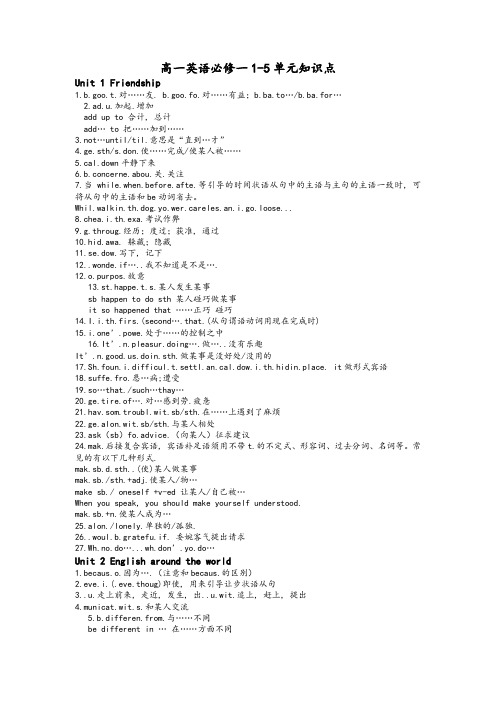
高一英语必修一1-5单元知识点Unit 1 Friendship1.b.goo.t.对……友. b.goo.fo.对……有益;b.ba.to…/b.ba.for…2.ad.u.加起.增加add up to 合计, 总计add… to 把……加到……3.not…until/til.意思是“直到…才”4.ge.sth/s.don.使……完成/使某人被……5.cal.down平静下来6.b.concerne.abou.关.关注7.当while.when.before.afte.等引导的时间状语从句中的主语与主句的主语一致时, 可将从句中的主语和be动词省去。
Whil.walkin.th.dog.yo.wer.careles.an.i.go.loose...8.chea.i.th.exa.考试作弊9.g.throug.经历;度过;获准, 通过10.hid.awa. 躲藏;隐藏11.se.dow.写下, 记下12..wonde.if…..我不知道是不是….12.o.purpos.故意13.st.happe.t.s.某人发生某事sb happen to do sth 某人碰巧做某事it so happened that ……正巧碰巧14.I.i.th.firs.(second….that.(从句谓语动词用现在完成时)15.i.one’.powe.处于……的控制之中16.It’.n.pleasur.doing….做…..没有乐趣It’.doin.sth.做某事是没好处/没用的17.Sh.foun.i.difficul.t.settl.an.cal.dow.i.th.hidin.place. it做形式宾语18.suffe.fro.患…病;遭受19.so…that./such…thay…20.ge.tire.of….对…感到劳.疲惫21.hav.som.troubl.wit.sb/sth.在……上遇到了麻烦22.ge.alon.wit.sb/sth.与某人相处23.ask(sb)fo.advice.(向某人)征求建议24.mak.后接复合宾语, 宾语补足语须用不带t.的不定式、形容词、过去分词、名词等。
(完整版)高一英语必修一完整单词表

(完整版)高一英语必修一完整单词表Aa.m. /上午/ability /能力/able /能够/abnormal /不正常的/aboard /在船(车、飞机)上/about /关于;大约/above /在…上面/abroad /在国外/absence /缺席,不在场/absent /缺席的,不在的/absolute /绝对的/absolutely /完全地,绝对地/absorb /吸收/abstract /摘要;抽象的/abundance /丰富,充裕/abundant /丰富的,充裕的/abuse /滥用;虐待/academic /学术的/academy /学院/accelerate /加速/accent /口音/accept /接受/access /进入;通道/ accident /事故/accidental /意外的/ according to /根据/ account /账户;解释/ accumulate /积累/ accuracy /准确(性)/ accurate /准确的/accuse /指控/achieve /实现,达到/ achievement /成就/acid /酸/acknowledge /承认;致谢/ acquire /获得,学到/BCcancel /取消/cancer /癌症/candidate /候选人,应聘者/ candle /蜡烛/cap /帽子;上限/capable /有能力的/ capacity /容量;能力/capital /首都;资本/ captain /船长;队长/ capture /捕获,抓住/ carbon /碳/care /照顾;关心/career /职业,生涯/ careful /小心的/carefully /仔细地/cargo /货物/carry /携带,搬运/carry out /实施,执行/ cart /手推车/case /情况;案例/cash /现金/cassette /盒式磁带/cast /投,掷;演员阵容/ castle /城堡/casual /随意的,非正式的/ catalog /目录/catch /抓住;感染/ category /类别,种类/ cater /提供饮食;迎合/ cathedral /大教堂/ Catholic /天主教的/cause /原因;事业/ caution /小心,谨慎/ cautious /谨慎的/cave /洞穴/CD /光盘/cease /停止/celebrate /庆祝/ celebration /庆祝活动/ cell /细胞;电池/cellar /地下室/cement /水泥/cent /分币/centigrade /摄氏度/ centimeter /厘米/central /中心的,中央的/ centre /中心/century /世纪/cereal /谷物,麦片/ certain /确定的,无疑的/ certainly /当然,一定/ certainty /确定性/ certificate /证书/ champion /冠军/chance /机会/change /改变/channel /频道;水道/ chapter /章节/character /性格;角色/ characteristic /特点/ charge /收费;指控/ charity /慈善/chart /图表/chase /追逐/cheap /便宜的/cheat /欺骗/check /检查/cheek /脸颊/cheer /欢呼/cheerful /愉快的/ cheese /奶酪/chemical /化学的/ chemist /化学家;药剂师/ chemistry /化学/cheque /支票/chess /国际象棋/chest /胸部/chew /咀嚼/chicken /鸡肉;胆小的人/chief /首领,领导/child /孩子/childhood /童年/chill /寒冷/chimney /烟囱/china /瓷器/Chinese /中国的;中国人/ chip /芯片;碎片/ chocolate /巧克力/choice /选择/choose /选择/chop /砍,剁/Christian /基督教的/ Christmas /圣诞节/church /教堂/cigarette /香烟/circle /圆圈/ circumference /周长/ circumstance /情况,环境/ citizen /公民/city /城市/civil /公民的;国内的/ civilization /文明/claim /声称;要求/clap /鼓掌/clarify /澄清/class /班级;类别/ classical /古典的/ classification /分类/ classify /分类/ classmate /同班同学/ clause /条款/clean /干净的;清洁/ clear /清晰的;清除/ clerk /职员/click //client /客户/cliff /悬崖/climate /气候/climb /爬,攀登/ clinic /诊所/clinical /临床的/ clock /时钟/clone /克隆/close /关闭;亲密的/ closely /紧密地/cloth /布料/clothe /给…穿衣/clothes /衣服/cloud /云/cloudy /多云的/club /俱乐部/clue /线索/clumsy /笨拙的/coach /教练;长途汽车/ coal /煤/coarse /粗糙的/coast /海岸/coat /外套,大衣/coax /哄骗//代码,密码/coffee /咖啡/coil /卷,盘绕/coin /硬币/collapse /倒塌,崩溃/ collar /衣领/ colleague /同事/ collect /收集/ collection /收藏品/ collective /集体的/ college /大学/ collision /碰撞/colony /殖民地/color /颜色/column /柱,栏目/Dconceal /隐藏/concentrate /集中/ concentration /集中;浓度/ concept /概念/concern /关心;涉及/ concerned /担心的;相关的/ concert /音乐会/conclude /结束;得出结论/ conclusion /结论/concrete /具体的;混凝土/ condition /条件;状况/ conduct /行为;指导/ conductor /导体;指挥/ conference /会议/confess /坦白/confidence /信心/ confident /自信的/confine /限制/confirm /确认/conflict /冲突/conform /遵守;适应/ confront /面对/confuse /使困惑/ confusion /混乱/ congratulate /祝贺/ congratulation /祝贺/ connect /连接/ connection /连接;联系/ conquer /征服/ conscience /良心/ conscious /意识到的/ consciousness /意识/ consent /同意/ consequence /结果/ consequently /因此/ conservation /保护/ conservative /保守的/ consider /考虑/ considerable /相当大的/ considerate /考虑周到的/ consideration /考虑/ consist /组成/ consistent /一致的/ constant /不变的;常数/constitute /构成/ constitution /宪法/ construct /建造/ construction /建设/ consult /咨询/ consume /消耗/ consumer /消费者/ contact /接触;联系/ contain /包含/ container /容器/ contemporary /当代的/ content /内容;满足的/ contest /竞赛/context /语境/ continent /大陆/ continue /继续/ continuous /连续的/ contract /合同;收缩/ contradict /相矛盾/ contrary /相反的/ contrast /对比/ contribute /贡献/ contribution /贡献/ control /控制/controversial /有争议的/ controversy /争议/ convenience /便利/ convenient /方便的/ convention /习俗;公约/ conventional /传统的/ conversation /对话/ conversely /相反地/ convert /转换/convey /传达/convince /说服/cook /烹饪/cookie /饼干/cool /凉爽的;冷静的/ cooperate /合作/ cooperation /合作/ coordinate /协调/cope /应对/copper /铜/copy /复制/copyright /版权/cord /绳索/core /核心/corn /玉米/corner /角落/ corporate /公司的/ corporation /公司/ correct /正确的;纠正/ correction /改正/ correspond /对应/ correspondence /通信/ correspondent /通讯员/ corresponding /相应的/ corridor /走廊/cost /成本;花费/ costly /昂贵的/ cottage /小屋/cotton /棉花/cough /咳嗽/could /能,可能/count /计算;伯爵/ counter /柜台;相反地/ country /国家/ countryside /乡村/ county /县/couple /夫妇;一对/ courage /勇气/course /课程;过程/court /法院;球场/cousin /堂(表)兄弟姐妹/ cover /覆盖/cow /母牛/crack /裂缝/craft /工艺/crane /起重机/crash /碰撞/crawl /爬行/crazy /疯狂的/cream /奶油/create /创造/creature /生物/credit /信用;学分/creep /爬行/crew /全体船员/cricket /板球/crime /犯罪/criminal /犯罪的/cripple /跛子;削弱/ crisis /危机/critic /批评家/critical /批评的;关键的/ criticism /批评/crop /作物/cross /交叉;十字架/ crossing /十字路口/ crowd /人群/crown /王冠/crude /粗鲁的;未加工的/ cruel /残忍的/cruise /巡航/crush /压碎/crust /地壳;面包皮/cry /哭;叫喊/crystal /水晶/cube /立方体/cubic /立方体的/cue /暗示/cuisine /烹饪/cultivate /培养/culture /文化/cup /杯子/cure /治愈/curiosity /好奇心/ curious /好奇的/ currency /货币/current /当前的;电流/curriculum /课程/ curse /诅咒/cursor /光标/curve /曲线/cushion /垫子/ custom /习俗/ customer /顾客/ customs /海关/cut /切割/cycle /周期;自行车/ Eeach /每一个/eager /渴望。
人教版高一英语必修一
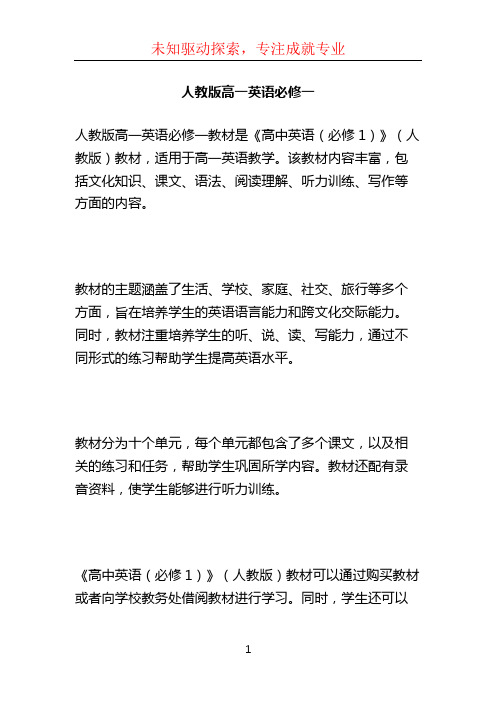
人教版高一英语必修一
人教版高一英语必修一教材是《高中英语(必修1)》(人教版)教材,适用于高一英语教学。
该教材内容丰富,包括文化知识、课文、语法、阅读理解、听力训练、写作等方面的内容。
教材的主题涵盖了生活、学校、家庭、社交、旅行等多个方面,旨在培养学生的英语语言能力和跨文化交际能力。
同时,教材注重培养学生的听、说、读、写能力,通过不同形式的练习帮助学生提高英语水平。
教材分为十个单元,每个单元都包含了多个课文,以及相关的练习和任务,帮助学生巩固所学内容。
教材还配有录音资料,使学生能够进行听力训练。
《高中英语(必修1)》(人教版)教材可以通过购买教材或者向学校教务处借阅教材进行学习。
同时,学生还可以
通过课外阅读、听写、口语练习等方式提高自己的英语能力。
新课标(人教版)高一英语必修一课文详解及练习(附答案)
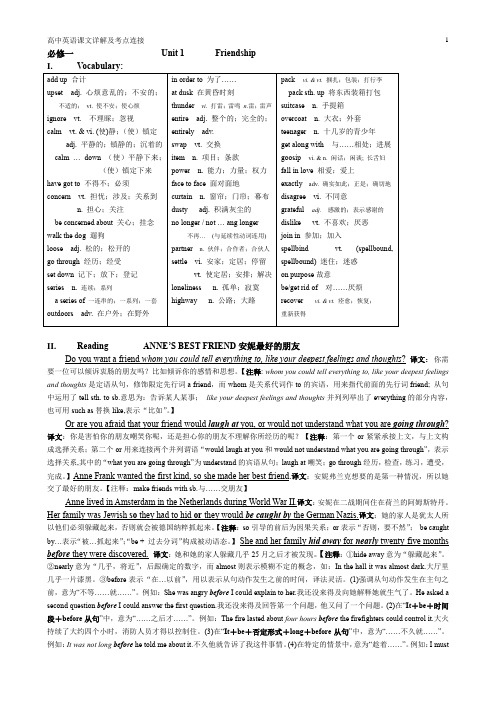
必修一Unit 1 FriendshipII.Reading ANNE’S BEST FRIEND安妮最好的朋友Do you want a friend whom you could tell everything to, like your deepest feelings and thoughts? 译文:你需要一位可以倾诉衷肠的朋友吗?比如倾诉你的感情和思想。
【注释: whom you could tell everything to, like your deepest feelings and thoughts是定语从句,修饰限定先行词a friend,而whom是关系代词作to的宾语,用来指代前面的先行词friend; 从句中运用了tell sth. to sb.意思为:告诉某人某事;like your deepest feelings and thoughts并列列举出了everything的部分内容,也可用such as替换like,表示“比如”。
】Or are you afraid that your friend would laugh at you, or would not understand what you are going through? 译文:你是害怕你的朋友嘲笑你呢,还是担心你的朋友不理解你所经历的呢?【注释:第一个or紧紧承接上文,与上文构成选择关系;第二个or用来连接两个并列谓语“would laugh at you和would not understand what you are going through”,表示选择关系,其中的“what you are going through”为understand的宾语从句;laugh at嘲笑;go through经历,检查,练习,遭受,完成。
】Anne Frank wanted the first kind, so she made her best friend.译文:安妮弗兰克想要的是第一种情况,所以她交了最好的朋友。
(完整版)高一英语必修一课文原文及译文

(完整版)高一英语必修一课文原文及译文高一英语必修一课文原文及译文必修一 Unit1Anne’s Best Friend Do you want a friend whom you could tell everything to, like your deepest feelings and thoughts? Or are you afraid that your friend would laugh at you, or would not understand what you are going through? Anne Frank wanted the first kind, so she made her diary her best friend. Anne lived in Amsterdam in the Netherlands during World War Ⅱ. Her family was Jewish so nearly twenty-five months before they were discovered. During that time the only true friend was her diary. She said, ”I don’t want to set down a series of facts in a diary as most people do, but I want this diary itself to be my friend, and I shall call my friend Ki tty.” Now read how she felt after being in the hiding place since July 1942. Thursday 15th June, 1944 Dear Kitty, I wonder if it’s because I haven’t been able to be outdoors forso long that I’ve grown so crazy about everything to do with nature. I can well remember that there was a time when a deep blue sky, the song of the birds, moonlight and flowers could never have kept me spellbound. That’s changed since I was here. …For example, one evening when it was so warm, I stayed awake on purpose until half past eleven in order to have a good look at the moon by my self. But as the moon gave far too much light, I didn’t dare open a window. Another time five months ago, I happened to be upstairs at dusk when the window was open. I didn’t go downstairs until the window bad to be shut. The dark, rainy evening, the wind, the thundering clouds held me entirely in their power; it was the first time in a year and a halfthat I’d seen the night face to face… …Sadly…I am only able to look at nature through dirty curtains hanging before very dusty windows. It’s no pleasurelooking through these any longer because nature is one thing that really must be experienced.Yours, Anne第一单元友谊Reading 安妮最好的朋友你是不是想有一位无话不谈能推心置腹的朋友呢?或者你是不是担心你的朋友会嘲笑你,会不理解你目前的困境呢?安妮·弗兰克想要的是第一种类型的朋友,于是她就把日记当成了她最好的朋友。
高中英语必修一

高中英语必修一高中的英语涉及范围很广,学习必修一的英语知识开始,就要养成勤奋刻苦的精神,认真学好英语这门科目。
下面是百分网小编为大家整理的高一英语必修一知识总结,希望对大家有用!高一英语必修一必备知识1. for the first time 第一次;首先 at first; first of all2. have a good flight (坐飞机)旅途愉快3. all the way 一路4. at all (否定:根本; 疑问:到底; 条件:竟然)above all 首先;首要的 after all 毕竟; in all 总共5. make oneself at home 不拘束,别客气6. There you are. 你来了。
Here you are. 给你。
7. all around the world 世界各地 throughout the world8. the majority of 大多数的 the minority of 9. in total; in all; altogether 总共10. the number of …的数量 (large; small 谓语动词单数)a number of 一些; 许多11. except for 除了...之外; 要不是except 除了...都; besides 除了...还;except +从句except (除去)指在整体中除去行为未发生者 (不包括在内)except for (除了…之外)指在一个整体中除去其中某个或某些因素,前后两个名词性质不同。
except that (除去;除掉) 后接从句,还有except when, except what; except where等 besides (除了…还) 包括在整体之内but (除了...之外) 和except 同义,与否定词或疑问词连用高一英语必修一知识归纳介词+关系代词的常见结构①介词+whichwhomThis is the famous singerabout whom we have often talked.这就是那位我们经常谈论的著名歌唱家。
高一英语必修1知识点总结(精选8篇)
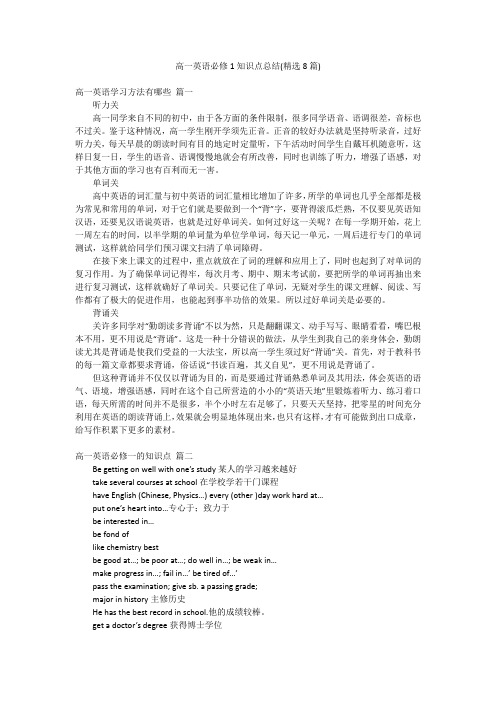
高一英语必修1知识点总结(精选8篇)高一英语学习方法有哪些篇一听力关高一同学来自不同的初中,由于各方面的条件限制,很多同学语音、语调很差,音标也不过关。
鉴于这种情况,高一学生刚开学须先正音。
正音的较好办法就是坚持听录音,过好听力关,每天早晨的朗读时间有目的地定时定量听,下午活动时间学生自戴耳机随意听,这样日复一日,学生的语音、语调慢慢地就会有所改善,同时也训练了听力,增强了语感,对于其他方面的学习也有百利而无一害。
单词关高中英语的词汇量与初中英语的词汇量相比增加了许多,所学的单词也几乎全部都是极为常见和常用的单词,对于它们就是要做到一个“背”字,要背得滚瓜烂熟,不仅要见英语知汉语,还要见汉语说英语,也就是过好单词关。
如何过好这一关呢?在每一学期开始,花上一周左右的时间,以半学期的单词量为单位学单词,每天记一单元,一周后进行专门的单词测试,这样就给同学们预习课文扫清了单词障碍。
在接下来上课文的过程中,重点就放在了词的理解和应用上了,同时也起到了对单词的复习作用。
为了确保单词记得牢,每次月考、期中、期末考试前,要把所学的单词再抽出来进行复习测试,这样就确好了单词关。
只要记住了单词,无疑对学生的课文理解、阅读、写作都有了极大的促进作用,也能起到事半功倍的效果。
所以过好单词关是必要的。
背诵关关许多同学对“勤朗读多背诵”不以为然,只是翻翻课文、动手写写、眼睛看看,嘴巴根本不用,更不用说是“背诵”。
这是一种十分错误的做法,从学生到我自己的亲身体会,勤朗读尤其是背诵是使我们受益的一大法宝,所以高一学生须过好“背诵”关。
首先,对于教科书的每一篇文章都要求背诵,俗话说“书读百遍,其义自见”,更不用说是背诵了。
但这种背诵并不仅仅以背诵为目的,而是要通过背诵熟悉单词及其用法,体会英语的语气、语境,增强语感,同时在这个自己所营造的小小的“英语天地”里锻炼着听力、练习着口语,每天所需的时间并不是很多,半个小时左右足够了,只要天天坚持,把零星的时间充分利用在英语的朗读背诵上,效果就会明显地体现出来,也只有这样,才有可能做到出口成章,给写作积累下更多的素材。
高一英语必修一句型
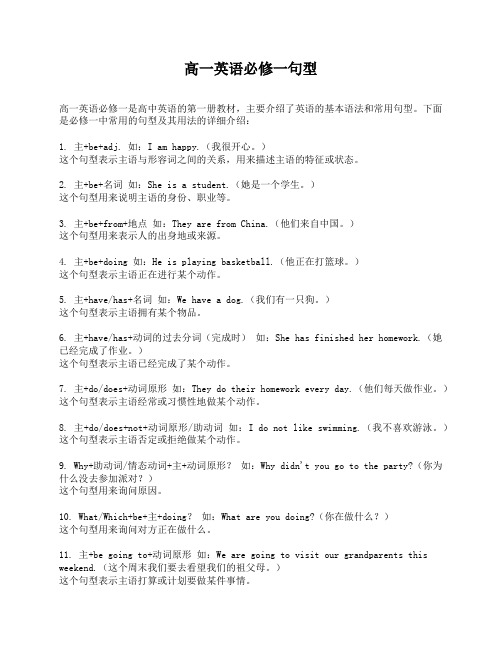
高一英语必修一句型高一英语必修一是高中英语的第一册教材,主要介绍了英语的基本语法和常用句型。
下面是必修一中常用的句型及其用法的详细介绍:1. 主+be+adj. 如:I am happy.(我很开心。
)这个句型表示主语与形容词之间的关系,用来描述主语的特征或状态。
2. 主+be+名词如:She is a student.(她是一个学生。
)这个句型用来说明主语的身份、职业等。
3. 主+be+from+地点如:They are from China.(他们来自中国。
)这个句型用来表示人的出身地或来源。
4. 主+be+doing 如:He is playing basketball.(他正在打篮球。
)这个句型表示主语正在进行某个动作。
5. 主+have/has+名词如:We have a dog.(我们有一只狗。
)这个句型表示主语拥有某个物品。
6. 主+have/has+动词的过去分词(完成时)如:She has finished her homework.(她已经完成了作业。
)这个句型表示主语已经完成了某个动作。
7. 主+do/does+动词原形如:They do their homework every day.(他们每天做作业。
)这个句型表示主语经常或习惯性地做某个动作。
8. 主+do/does+not+动词原形/助动词如:I do not like swimming.(我不喜欢游泳。
)这个句型表示主语否定或拒绝做某个动作。
9. Why+助动词/情态动词+主+动词原形?如:Why didn't you go to the party?(你为什么没去参加派对?)这个句型用来询问原因。
10. What/Which+be+主+doing?如:What are you doing?(你在做什么?)这个句型用来询问对方正在做什么。
11. 主+be going to+动词原形如:We are going to visit our grandparents this weekend.(这个周末我们要去看望我们的祖父母。
高一英语必修1知识点总结

高一英语必修1知识点总结高一英语必修1知识点总结「篇一」1.一般现在时:一般现在时大多用动词原形来表示。
Behave在人称和数上应按自己的变化规则与主语保持一致。
其他动词若其主语是第三人称单数,则应按动词第三人称单数的变化规律变化。
(1)表示主语现在所处的状态及所具备的特征、性格、能力等。
Eg:They are both tired and hungry。
(2)表示习惯性的,反复出现的动作与状态。
常用时间状语:always often sometimes now and then every day(3)表示客观事实或普遍真理。
Eg:The earth moves around the sun。
(4)在时间状语从句和条件状语从句表示将来的动作。
Eg:If it doesn’t rain tomorrow,we will go climbing。
(5)表示按规定预计要发生的动作,只限于go,come,leave,start,stay,return,begin等。
(6)在某些以have,there开头的句子中,用动词go,come的一般现在时表示正在发生的动作。
Eg:Here comes the bus!2.现在进行时:(1)表示说话时正在进行的动作;(2)表示即将发生的或按计划安排好的动作,多限于go,come,start,leave,return,arrive,stay,fly等表示运动方向的动词,句中往往有表示将来的时间状语。
(3)少数动词如go,come,leave,arrive,return,begin,do,die,lose等现在进行时可以表示预计即将发生的动作;(4)表示反复发生的动作。
3.以-ing和-ed结尾的形容词:以-ed结尾的形容词用来描述人的精神状态或人对事物的态度或感受;以-ing 结尾的形容词有“令人.的”意思,常用来指物。
高一英语必修1知识点总结「篇二」单词at hand在附近,即将到来hand down流传下来,传给hand in交上,递交hand in hand手拉着手,联合hand on传下来,依次传递hand out分发,散发hand over交出,移交in hand在控制中on the other hand另一方面hand about闲荡,徘徊hand on继续下去,等一下hand up挂断happen to碰巧,偶然hardly any几乎没有,几乎什么也不hardly when刚一就in haste急忙的,草率的have on穿着,戴着head for驶向,走向lose one‘s head不知所措at heart实质上learn by heart记住,背诵heart and soul全心全意lose heart丧失勇气,失去信心can‘t help禁不住,不得不help oneself自取所需get hold of抓住,掌握hold back踌躇,退缩,阻止,抑制hold on继续,紧握不放hold on to紧紧抓住,坚持hold up举起,承载,阻挡at home在家,在国内,自在自如home and aboard国内外in honor of为纪念,向表示敬意on one‘s honor以名誉担保how about如何,怎样高一英语必修1知识点总结「篇三」重点句子1. Whichever and whatever you like, there is a theme park for you!2. With all these attractions, no wonder tourism is increasing wherever there is a Disneyland。
人教版高一英语必修一知识点 史上最全高一必备

人教版高一英语必修一知识点史上最全高一必备一、重点短语1.go through 经历,经受get through 通过;完成;接通电话2. set down 记下,放下3. a series of 一系列4 on purpose 有目的的5. in order to 为了6. at dusk 傍晚,黄昏时刻7. face to face 面对面(这是人教版高一英语必修一常出现的短语)8. fall in love 爱上9. join in 参加(某个活动);take part in 参加(活动)join 加入(组织,团队,并成为其中一员)10. calm down 冷静下来11. suffer from 遭受12. be/get tired of…对…感到厌倦13. be concerned about 关心14. get on/along well with 与…相处融洽(这是人教版高一英语必修一重点短语)15. be good at/do well in 擅长于…16. find it + adj. to do sth. 发现做某事是…人教版高一英语必修一重点词组:人教版高一英语必修一有哪些重要的词组呢?下面是小编整理的,供参考:1. fond of “喜爱,爱好” 接名词、代词或动词的-ing形式。
例如:He’s fond of swimming. 他喜欢游泳。
Are you fond of fresh vegetables. 你喜欢新鲜蔬菜吗?He is fond of his research work. 他喜爱他的研究工作。
2. hunt for = look for寻找(人教版高一英语必修一重点词组)I have found the book I was hunting for.我找到了那本我在找的书。
hunt for a job 找工作3. in order to, so as to 这两个词组都可引导不定式作目的状语, in order to可放于句首, so as to则不能, 其否定形式为in order not to / so as not to. 如:He went to Beijing in order / so as to attend an important meeting.In order to be noticed, he shouted and waved to us.为了让我们注意他, 他朝我们又是叫喊又是挥手。
- 1、下载文档前请自行甄别文档内容的完整性,平台不提供额外的编辑、内容补充、找答案等附加服务。
- 2、"仅部分预览"的文档,不可在线预览部分如存在完整性等问题,可反馈申请退款(可完整预览的文档不适用该条件!)。
- 3、如文档侵犯您的权益,请联系客服反馈,我们会尽快为您处理(人工客服工作时间:9:00-18:30)。
Unit 1 Friendship一、词汇1. upset adj.心烦意乱的;不安的;不适的vt.使不安;使心烦2. ignore vt.不理睬;忽视= neglect ignorant adj. 无知的,不知道的3. calm (使)平静;(使)镇定adj.平静的;镇静的;沉着的calm down! (vi. + adv.) e.g. My words calm you down.4. concern vt.(使)但有;涉及;关系到n.担心;关注;(利害)关系care about worry aboutconcern oneself with / in 从事(参与、干涉)concern oneself about / for…因为……担忧(关心)某人concern sb./sth 关心某人(某事)as/so far as…be concerned就……而言as concerns 关于(=concerning)feel/show concern about for…担心(关心、挂念)……be concerned with 与……有关的be concerned about/for 关心5.loose adj.松的;松开的vt. 使变松loose sth e.g. I loose my belt.6.go through = experience = undertakego through的含义(1)穿过,通过(2)审阅,检查(3)翻找,搜寻(4)经历(痛苦,困难等)(5)通过,成功7.set down 记下;放下;登记= keep a record of8.outdoors = in the open air在户外9.on purpose = purposely故意with the purpose of doing something. “目的是……”for the purpose 与with the purpose of两者的意思相同,差异在于用for时,目的能否实现还不知道;用with时,暗示目的能实现。
10.in order to = so as to 为了……In order to +动词原形,表示“目的是……,以便……,为了……”(1)用作目的状语时,不定式的逻辑主语和句子的主语通常要一致,是同一人或物。
(2)其位置灵活,可放在句首或句中。
(3)其否定形式要在to前加not,即in order not to + 动词原形。
In order to 和so as to 的区别三者后接动词原形,做目的状语的用法一致,但so as to 不可用于句首引导目的状语,只可用于句中。
---------------------------------------------------------------------------------------------------------------------------------------------11.at dusk在黄昏时刻= at dark12.thunder vi.打雷;雷鸣n.雷,雷声13.entire adj.整个的,全部的;完全的= whole14.face to face 面对面的;亲自= in personface-to-face adj.面对面的【相似词组】1)heart to heart 坦诚地2)shoulder to shoulder 肩并肩地3)back to back 背对背地4)hand in hand 手拉手地5)arm in arm臂挽臂地6)side by side 并肩地7)step by step 逐步地15.dusty adj.满是灰尘的dust n.尘土vt. 打扫 e.g. Dusk the cupboard16.no longer = no more = not … any longer = no … any more17.partner n.伙伴;合作者;合伙人= companypartnership伙伴关系18.settle vi.安家;定居;停留vt.使定居settle down 安静It’s settled = It’s a deal.19.suffer vi.忍受;遭受suffer from遭受;患病Suffer/experience pain/defeatSuffering n.痛苦Suffer , suffer from &suffer with20.recover vi.&vt. 痊愈;恢复;重新获得recovery e.g. I wish you have a speedy recovery.21.pack 打包;包装= package pack sth up 将(东西)打包22.get/be tired of 对……感到厌烦23.grateful adj.感激的;表示感谢的appreciative 感激24.join in = take part in = participateenter upsign up for注册;报名25.surey n.&v.(1)n.概论,全面评述。
常用于结构:make a general survey of sth 纵观某事物e.g. I am not good at making a general survey of matters.我不善于总管事物(2)n.民意调查,民意测验。
常用于结构:make a survey of sth.调查某事e.g. The reporter made a survey of river pollution. 记者对河流污染问题进行了调查。
(3)vt.查看,审视,眺望(风景等)e.g. The next morning we surveyed the damage caused by the fire. 次日清早我们查看了火灾的破坏情况。
26.add用作机务祸不及物动词,有“增加,增添”等意思,可构成如下短语add to 增添add...to…往……添加……add up(together)合计add up to 合计达,加起来总和是e.g. Fireworks added to the attraction of the festival night.烟火使节日之夜更加生色。
She added some salt to the soup. 她往汤里加了些盐Add up these figures and you will see which is the right answer.把这些数字加起来,你就会知道哪个是正确的答案。
It is reported that the number of visitors to the exhibition adds up to 15,000 every day.根据报道,每天老参观展览的人数达到15000人。
Please add a note to the posters and say that your teacher himself will play the last piece.请在海报上再加一条,说你的老师将亲自表演最后一个曲目。
27.crazy adj.疯狂的;愚蠢的;狂热的;着迷的be crazy to do sth (某人)做某事是疯狂的be crazy on/ about doing sth 对做某事十分狂热be crazy for sth. 渴望某事be crazy for sb. 迷恋某人be crazy with 因……而发疯drive sb. mad/crazy 是某人发疯craziness n.疯狂,狂热crazily adv.疯狂地like crazy 发疯似的28. a series of …一系列的……;一连串的……;一套(丛书、邮票)【series 指按次序排列或发生的相似的、相关或相同的事情。
】Series 是一个单复数同型的名词。
A series of meetings 一系列的会议 A series of exams 一连串的考试A series of textbooks 一套教科书Two series of stamps 两套邮票29.point n.点,论点,要点,观点,小数点,问题点,(时间)点,地点,特点,意义,得分v.指示,指着,对着,削尖point at /to sb.sth 指着某人(某物)的位置或方向point sth .at/towards sb./sth 以某物瞄准或对着某人(某物)point out 指出be on the point of doing sth. 正要做某事there is no point in doing…没有必要做……to the point 得要领的off the point 离题的point of view 观点,着眼点30.dare vt. 意为“敢,胆敢,敢于面对”常用在否定句、疑问句或条件从句中。
(1)作情态动词时,没有人称和数的变化,但有时太变化,后接动词原形。
(2)作行为动词时后接to do,否定句、疑问句中to可以省略。
municate v. communication n.交际,交流;信息,通讯,消息,交通。
32.join in 加入,参与join sb./the Party和某人一起/入党join(sb.)in (doing )sth (与某人一起)参加某项活动join,join in ,take part in & attend(1)join通常指参加某组织或团体,并成为其中的一员,其宾语往往是the army/party/team/club或sb.(2)join in 参加,其宾语一般是竞赛、娱乐、游戏等活动的名词,也可不加宾语。
(3)take part in指参加会议或群众性活动等,重在说明参加该活动并在其中发挥一定的作用,in后要加宾语。
(4)attend 出席,为正式用于,指参加会议、仪式、婚礼、葬礼、典礼及上课、上学、听报告等。
e.g. attend one’s lecture.wedding.33.reason n. 理由,原因,理性for a/an…reason 因为一个……的原因the reason for………的理由,……的原因reason + why/that引导的定语从句the reason. is + that引导的表语从句34.promise n. (1)【C】(+of/+that/+to do )承诺,诺言,保证(2)希望,前途vt. (1)允诺,答应(2)给人以……的指望;有……的可能vi.有指望,有前途二、句子及语法1.You are taking your end-of-term exam.本句中的现在进行时表示将来按计划要进行的动作,能这样用的常见动词有:arrive, come , go , get ,have , leave , return , sleep , stay , start , travel , work , play , wear , give , move等2.While walking the dog, you were careless and it got loose and was hit by a car.句中while walking the dog = while you are walking the dog.本句中while后面省略了主语you和be动词are。
